Journal of Allergy and Clinical Immunology
VerifiedAdded on 2022/09/18
|12
|2796
|16
AI Summary
Contribute Materials
Your contribution can guide someone’s learning journey. Share your
documents today.
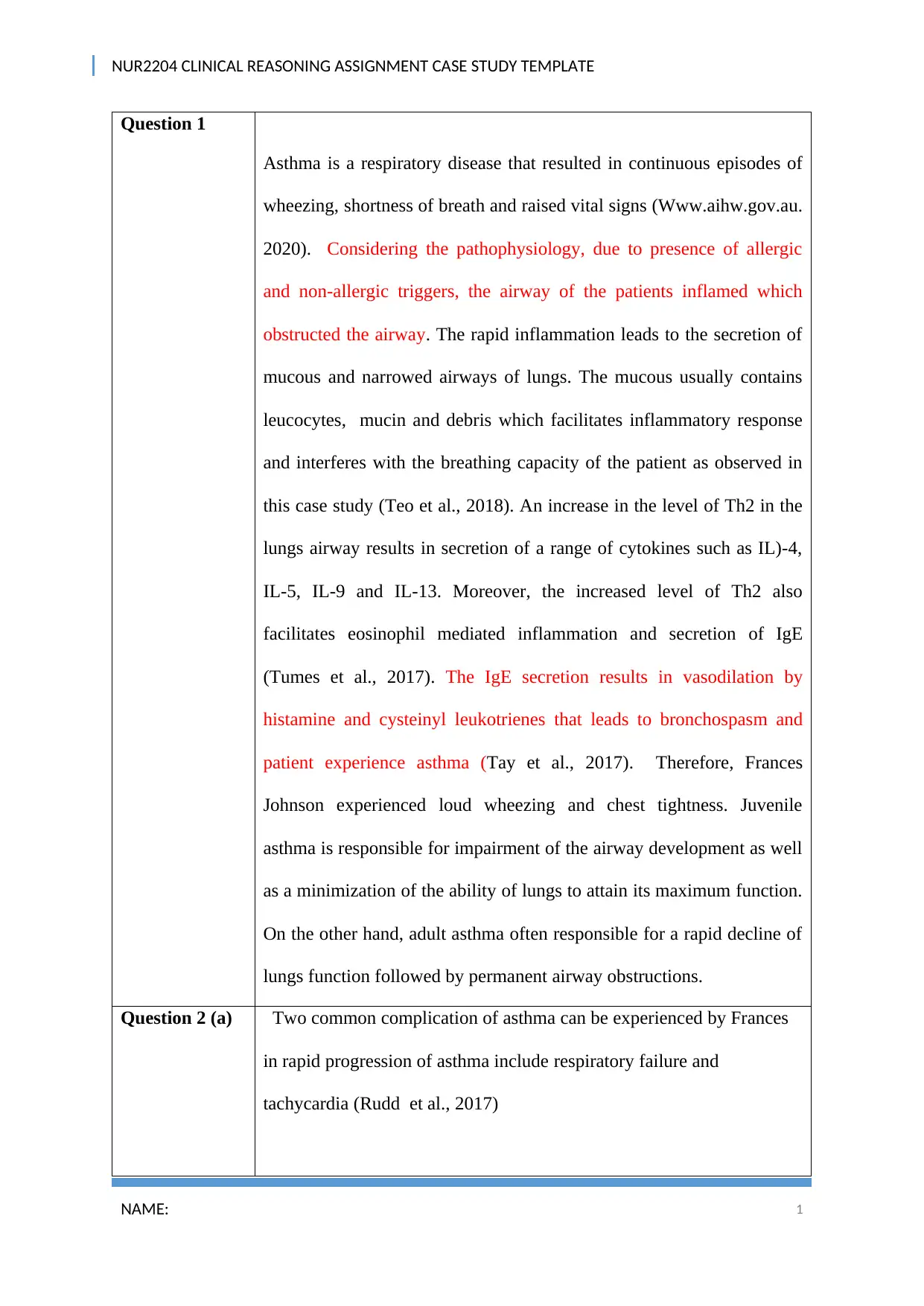
NUR2204 CLINICAL REASONING ASSIGNMENT CASE STUDY TEMPLATE
Question 1
Asthma is a respiratory disease that resulted in continuous episodes of
wheezing, shortness of breath and raised vital signs (Www.aihw.gov.au.
2020). Considering the pathophysiology, due to presence of allergic
and non-allergic triggers, the airway of the patients inflamed which
obstructed the airway. The rapid inflammation leads to the secretion of
mucous and narrowed airways of lungs. The mucous usually contains
leucocytes, mucin and debris which facilitates inflammatory response
and interferes with the breathing capacity of the patient as observed in
this case study (Teo et al., 2018). An increase in the level of Th2 in the
lungs airway results in secretion of a range of cytokines such as IL)-4,
IL-5, IL-9 and IL-13. Moreover, the increased level of Th2 also
facilitates eosinophil mediated inflammation and secretion of IgE
(Tumes et al., 2017). The IgE secretion results in vasodilation by
histamine and cysteinyl leukotrienes that leads to bronchospasm and
patient experience asthma (Tay et al., 2017). Therefore, Frances
Johnson experienced loud wheezing and chest tightness. Juvenile
asthma is responsible for impairment of the airway development as well
as a minimization of the ability of lungs to attain its maximum function.
On the other hand, adult asthma often responsible for a rapid decline of
lungs function followed by permanent airway obstructions.
Question 2 (a) Two common complication of asthma can be experienced by Frances
in rapid progression of asthma include respiratory failure and
tachycardia (Rudd et al., 2017)
NAME: 1
Question 1
Asthma is a respiratory disease that resulted in continuous episodes of
wheezing, shortness of breath and raised vital signs (Www.aihw.gov.au.
2020). Considering the pathophysiology, due to presence of allergic
and non-allergic triggers, the airway of the patients inflamed which
obstructed the airway. The rapid inflammation leads to the secretion of
mucous and narrowed airways of lungs. The mucous usually contains
leucocytes, mucin and debris which facilitates inflammatory response
and interferes with the breathing capacity of the patient as observed in
this case study (Teo et al., 2018). An increase in the level of Th2 in the
lungs airway results in secretion of a range of cytokines such as IL)-4,
IL-5, IL-9 and IL-13. Moreover, the increased level of Th2 also
facilitates eosinophil mediated inflammation and secretion of IgE
(Tumes et al., 2017). The IgE secretion results in vasodilation by
histamine and cysteinyl leukotrienes that leads to bronchospasm and
patient experience asthma (Tay et al., 2017). Therefore, Frances
Johnson experienced loud wheezing and chest tightness. Juvenile
asthma is responsible for impairment of the airway development as well
as a minimization of the ability of lungs to attain its maximum function.
On the other hand, adult asthma often responsible for a rapid decline of
lungs function followed by permanent airway obstructions.
Question 2 (a) Two common complication of asthma can be experienced by Frances
in rapid progression of asthma include respiratory failure and
tachycardia (Rudd et al., 2017)
NAME: 1
Secure Best Marks with AI Grader
Need help grading? Try our AI Grader for instant feedback on your assignments.
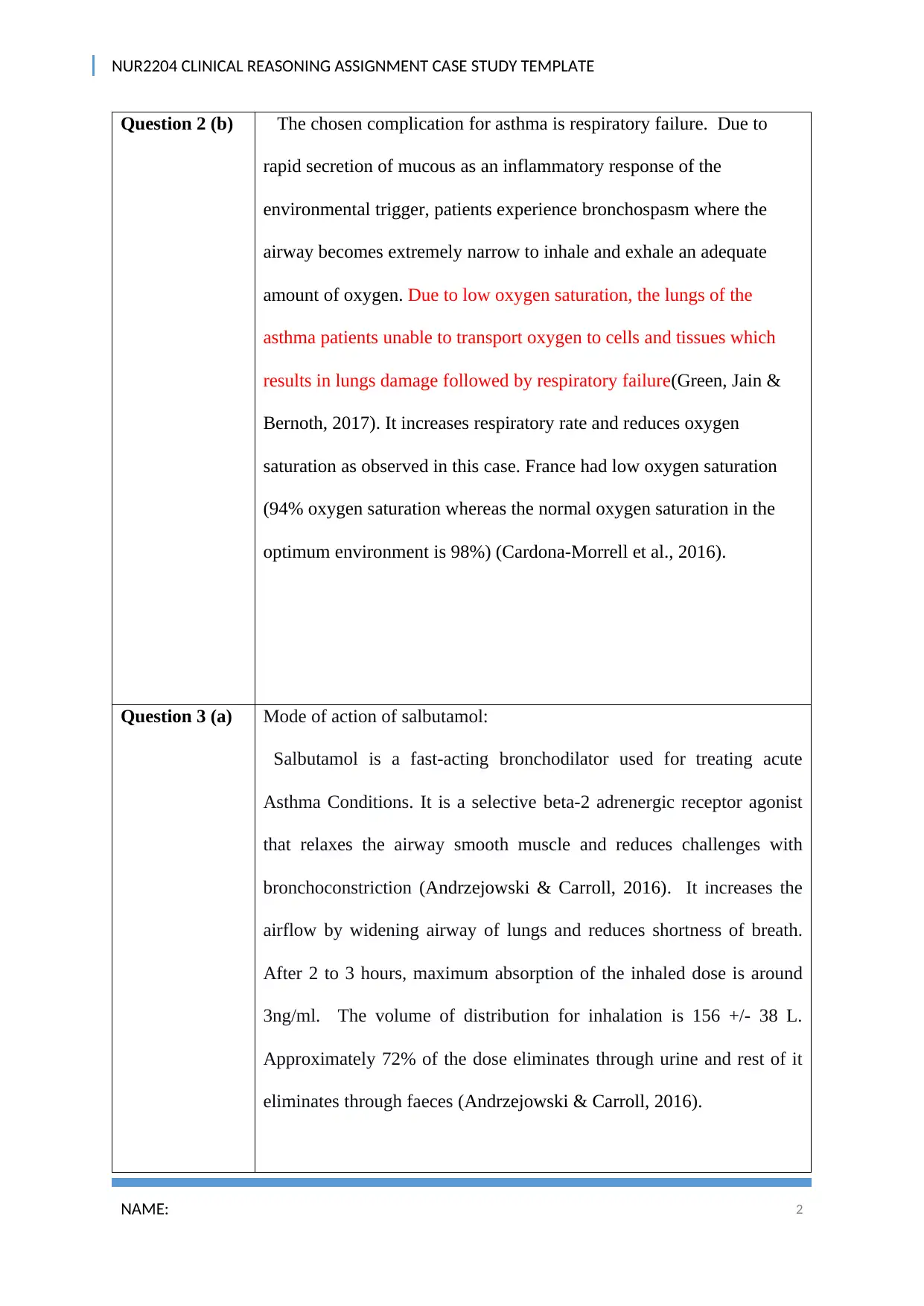
NUR2204 CLINICAL REASONING ASSIGNMENT CASE STUDY TEMPLATE
Question 2 (b) The chosen complication for asthma is respiratory failure. Due to
rapid secretion of mucous as an inflammatory response of the
environmental trigger, patients experience bronchospasm where the
airway becomes extremely narrow to inhale and exhale an adequate
amount of oxygen. Due to low oxygen saturation, the lungs of the
asthma patients unable to transport oxygen to cells and tissues which
results in lungs damage followed by respiratory failure(Green, Jain &
Bernoth, 2017). It increases respiratory rate and reduces oxygen
saturation as observed in this case. France had low oxygen saturation
(94% oxygen saturation whereas the normal oxygen saturation in the
optimum environment is 98%) (Cardona-Morrell et al., 2016).
Question 3 (a) Mode of action of salbutamol:
Salbutamol is a fast-acting bronchodilator used for treating acute
Asthma Conditions. It is a selective beta-2 adrenergic receptor agonist
that relaxes the airway smooth muscle and reduces challenges with
bronchoconstriction (Andrzejowski & Carroll, 2016). It increases the
airflow by widening airway of lungs and reduces shortness of breath.
After 2 to 3 hours, maximum absorption of the inhaled dose is around
3ng/ml. The volume of distribution for inhalation is 156 +/- 38 L.
Approximately 72% of the dose eliminates through urine and rest of it
eliminates through faeces (Andrzejowski & Carroll, 2016).
NAME: 2
Question 2 (b) The chosen complication for asthma is respiratory failure. Due to
rapid secretion of mucous as an inflammatory response of the
environmental trigger, patients experience bronchospasm where the
airway becomes extremely narrow to inhale and exhale an adequate
amount of oxygen. Due to low oxygen saturation, the lungs of the
asthma patients unable to transport oxygen to cells and tissues which
results in lungs damage followed by respiratory failure(Green, Jain &
Bernoth, 2017). It increases respiratory rate and reduces oxygen
saturation as observed in this case. France had low oxygen saturation
(94% oxygen saturation whereas the normal oxygen saturation in the
optimum environment is 98%) (Cardona-Morrell et al., 2016).
Question 3 (a) Mode of action of salbutamol:
Salbutamol is a fast-acting bronchodilator used for treating acute
Asthma Conditions. It is a selective beta-2 adrenergic receptor agonist
that relaxes the airway smooth muscle and reduces challenges with
bronchoconstriction (Andrzejowski & Carroll, 2016). It increases the
airflow by widening airway of lungs and reduces shortness of breath.
After 2 to 3 hours, maximum absorption of the inhaled dose is around
3ng/ml. The volume of distribution for inhalation is 156 +/- 38 L.
Approximately 72% of the dose eliminates through urine and rest of it
eliminates through faeces (Andrzejowski & Carroll, 2016).
NAME: 2
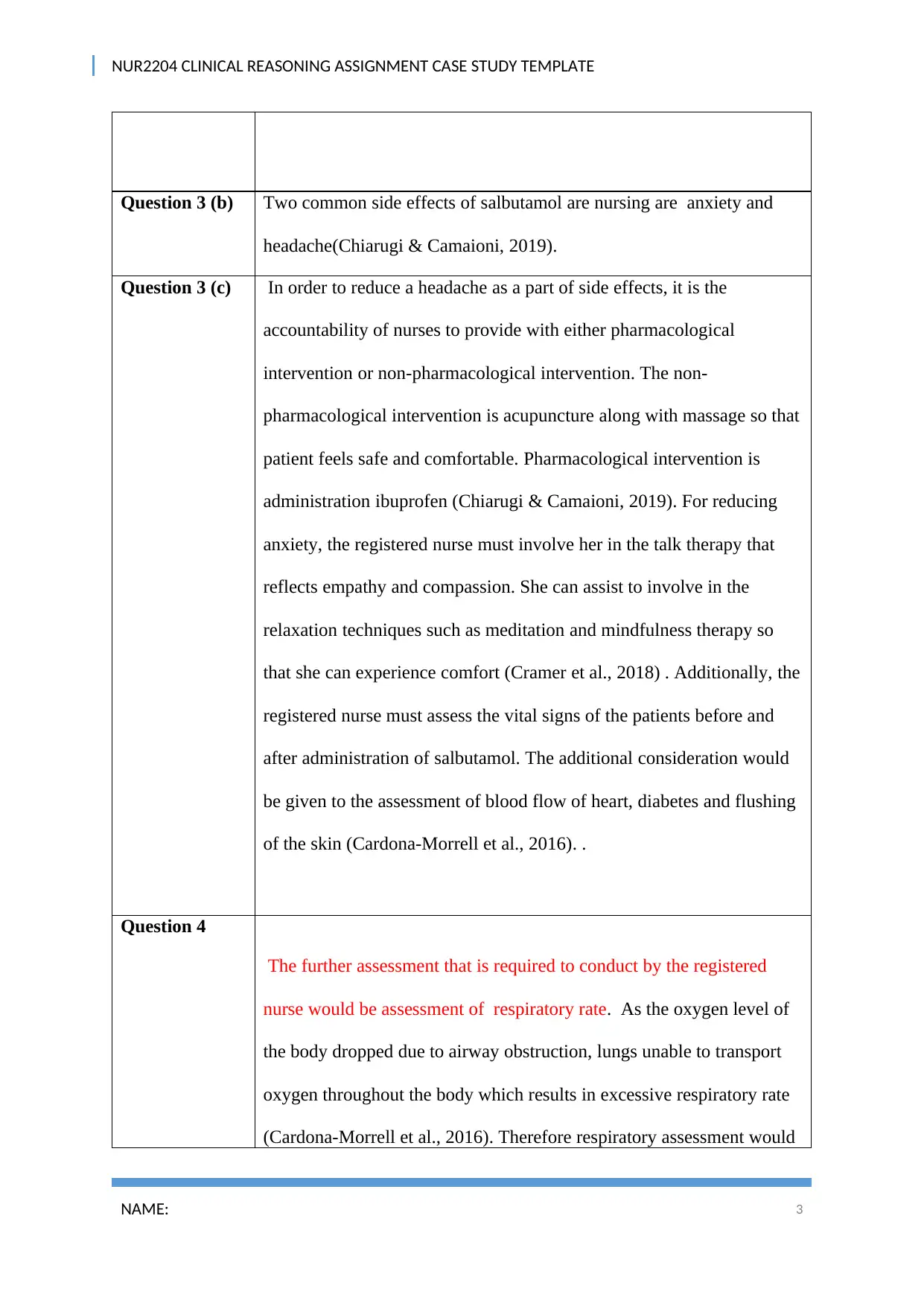
NUR2204 CLINICAL REASONING ASSIGNMENT CASE STUDY TEMPLATE
Question 3 (b) Two common side effects of salbutamol are nursing are anxiety and
headache(Chiarugi & Camaioni, 2019).
Question 3 (c) In order to reduce a headache as a part of side effects, it is the
accountability of nurses to provide with either pharmacological
intervention or non-pharmacological intervention. The non-
pharmacological intervention is acupuncture along with massage so that
patient feels safe and comfortable. Pharmacological intervention is
administration ibuprofen (Chiarugi & Camaioni, 2019). For reducing
anxiety, the registered nurse must involve her in the talk therapy that
reflects empathy and compassion. She can assist to involve in the
relaxation techniques such as meditation and mindfulness therapy so
that she can experience comfort (Cramer et al., 2018) . Additionally, the
registered nurse must assess the vital signs of the patients before and
after administration of salbutamol. The additional consideration would
be given to the assessment of blood flow of heart, diabetes and flushing
of the skin (Cardona-Morrell et al., 2016). .
Question 4
The further assessment that is required to conduct by the registered
nurse would be assessment of respiratory rate. As the oxygen level of
the body dropped due to airway obstruction, lungs unable to transport
oxygen throughout the body which results in excessive respiratory rate
(Cardona-Morrell et al., 2016). Therefore respiratory assessment would
NAME: 3
Question 3 (b) Two common side effects of salbutamol are nursing are anxiety and
headache(Chiarugi & Camaioni, 2019).
Question 3 (c) In order to reduce a headache as a part of side effects, it is the
accountability of nurses to provide with either pharmacological
intervention or non-pharmacological intervention. The non-
pharmacological intervention is acupuncture along with massage so that
patient feels safe and comfortable. Pharmacological intervention is
administration ibuprofen (Chiarugi & Camaioni, 2019). For reducing
anxiety, the registered nurse must involve her in the talk therapy that
reflects empathy and compassion. She can assist to involve in the
relaxation techniques such as meditation and mindfulness therapy so
that she can experience comfort (Cramer et al., 2018) . Additionally, the
registered nurse must assess the vital signs of the patients before and
after administration of salbutamol. The additional consideration would
be given to the assessment of blood flow of heart, diabetes and flushing
of the skin (Cardona-Morrell et al., 2016). .
Question 4
The further assessment that is required to conduct by the registered
nurse would be assessment of respiratory rate. As the oxygen level of
the body dropped due to airway obstruction, lungs unable to transport
oxygen throughout the body which results in excessive respiratory rate
(Cardona-Morrell et al., 2016). Therefore respiratory assessment would
NAME: 3
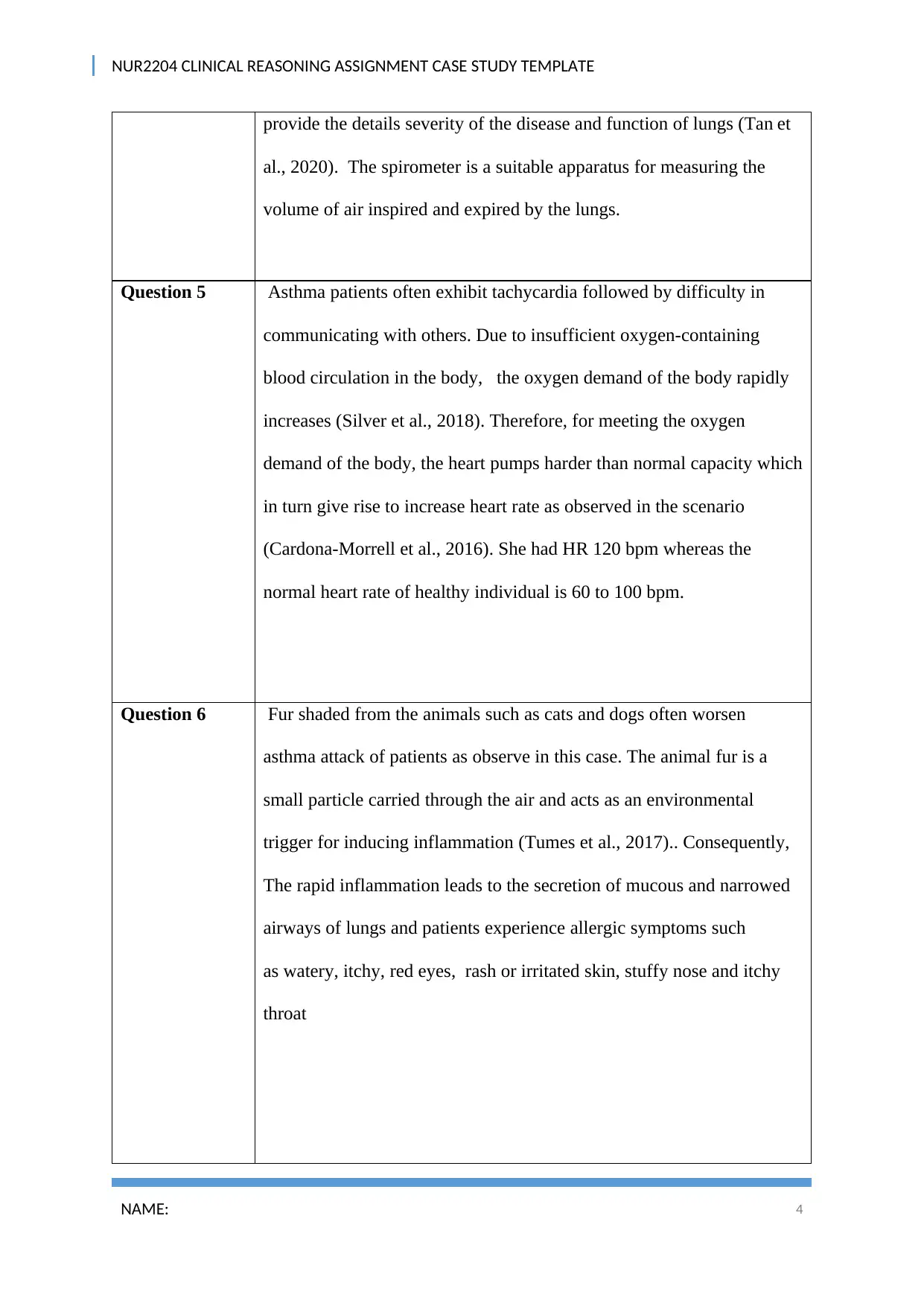
NUR2204 CLINICAL REASONING ASSIGNMENT CASE STUDY TEMPLATE
provide the details severity of the disease and function of lungs (Tan et
al., 2020). The spirometer is a suitable apparatus for measuring the
volume of air inspired and expired by the lungs.
Question 5 Asthma patients often exhibit tachycardia followed by difficulty in
communicating with others. Due to insufficient oxygen-containing
blood circulation in the body, the oxygen demand of the body rapidly
increases (Silver et al., 2018). Therefore, for meeting the oxygen
demand of the body, the heart pumps harder than normal capacity which
in turn give rise to increase heart rate as observed in the scenario
(Cardona-Morrell et al., 2016). She had HR 120 bpm whereas the
normal heart rate of healthy individual is 60 to 100 bpm.
Question 6 Fur shaded from the animals such as cats and dogs often worsen
asthma attack of patients as observe in this case. The animal fur is a
small particle carried through the air and acts as an environmental
trigger for inducing inflammation (Tumes et al., 2017).. Consequently,
The rapid inflammation leads to the secretion of mucous and narrowed
airways of lungs and patients experience allergic symptoms such
as watery, itchy, red eyes, rash or irritated skin, stuffy nose and itchy
throat
NAME: 4
provide the details severity of the disease and function of lungs (Tan et
al., 2020). The spirometer is a suitable apparatus for measuring the
volume of air inspired and expired by the lungs.
Question 5 Asthma patients often exhibit tachycardia followed by difficulty in
communicating with others. Due to insufficient oxygen-containing
blood circulation in the body, the oxygen demand of the body rapidly
increases (Silver et al., 2018). Therefore, for meeting the oxygen
demand of the body, the heart pumps harder than normal capacity which
in turn give rise to increase heart rate as observed in the scenario
(Cardona-Morrell et al., 2016). She had HR 120 bpm whereas the
normal heart rate of healthy individual is 60 to 100 bpm.
Question 6 Fur shaded from the animals such as cats and dogs often worsen
asthma attack of patients as observe in this case. The animal fur is a
small particle carried through the air and acts as an environmental
trigger for inducing inflammation (Tumes et al., 2017).. Consequently,
The rapid inflammation leads to the secretion of mucous and narrowed
airways of lungs and patients experience allergic symptoms such
as watery, itchy, red eyes, rash or irritated skin, stuffy nose and itchy
throat
NAME: 4
Secure Best Marks with AI Grader
Need help grading? Try our AI Grader for instant feedback on your assignments.
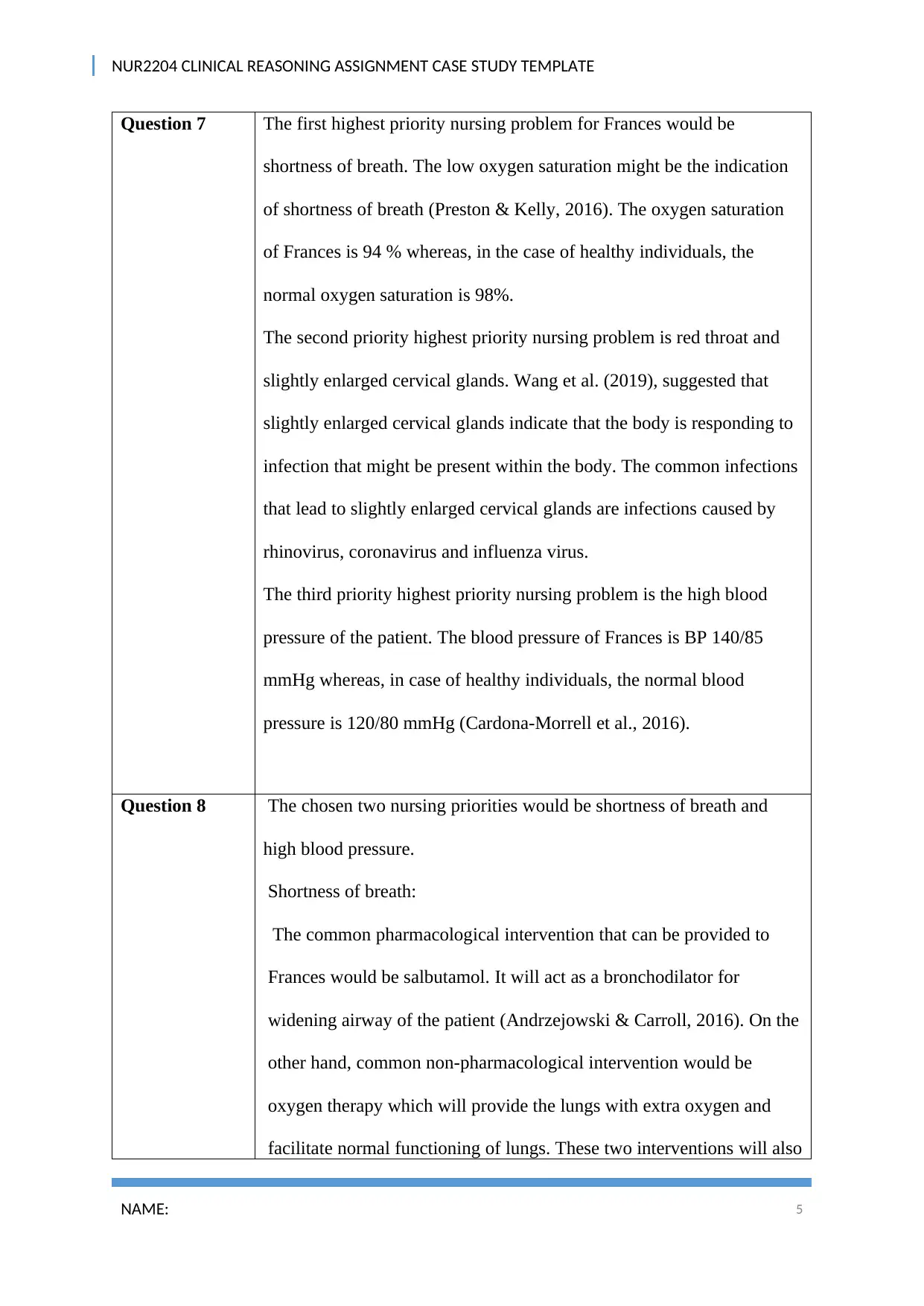
NUR2204 CLINICAL REASONING ASSIGNMENT CASE STUDY TEMPLATE
Question 7 The first highest priority nursing problem for Frances would be
shortness of breath. The low oxygen saturation might be the indication
of shortness of breath (Preston & Kelly, 2016). The oxygen saturation
of Frances is 94 % whereas, in the case of healthy individuals, the
normal oxygen saturation is 98%.
The second priority highest priority nursing problem is red throat and
slightly enlarged cervical glands. Wang et al. (2019), suggested that
slightly enlarged cervical glands indicate that the body is responding to
infection that might be present within the body. The common infections
that lead to slightly enlarged cervical glands are infections caused by
rhinovirus, coronavirus and influenza virus.
The third priority highest priority nursing problem is the high blood
pressure of the patient. The blood pressure of Frances is BP 140/85
mmHg whereas, in case of healthy individuals, the normal blood
pressure is 120/80 mmHg (Cardona-Morrell et al., 2016).
Question 8 The chosen two nursing priorities would be shortness of breath and
high blood pressure.
Shortness of breath:
The common pharmacological intervention that can be provided to
Frances would be salbutamol. It will act as a bronchodilator for
widening airway of the patient (Andrzejowski & Carroll, 2016). On the
other hand, common non-pharmacological intervention would be
oxygen therapy which will provide the lungs with extra oxygen and
facilitate normal functioning of lungs. These two interventions will also
NAME: 5
Question 7 The first highest priority nursing problem for Frances would be
shortness of breath. The low oxygen saturation might be the indication
of shortness of breath (Preston & Kelly, 2016). The oxygen saturation
of Frances is 94 % whereas, in the case of healthy individuals, the
normal oxygen saturation is 98%.
The second priority highest priority nursing problem is red throat and
slightly enlarged cervical glands. Wang et al. (2019), suggested that
slightly enlarged cervical glands indicate that the body is responding to
infection that might be present within the body. The common infections
that lead to slightly enlarged cervical glands are infections caused by
rhinovirus, coronavirus and influenza virus.
The third priority highest priority nursing problem is the high blood
pressure of the patient. The blood pressure of Frances is BP 140/85
mmHg whereas, in case of healthy individuals, the normal blood
pressure is 120/80 mmHg (Cardona-Morrell et al., 2016).
Question 8 The chosen two nursing priorities would be shortness of breath and
high blood pressure.
Shortness of breath:
The common pharmacological intervention that can be provided to
Frances would be salbutamol. It will act as a bronchodilator for
widening airway of the patient (Andrzejowski & Carroll, 2016). On the
other hand, common non-pharmacological intervention would be
oxygen therapy which will provide the lungs with extra oxygen and
facilitate normal functioning of lungs. These two interventions will also
NAME: 5
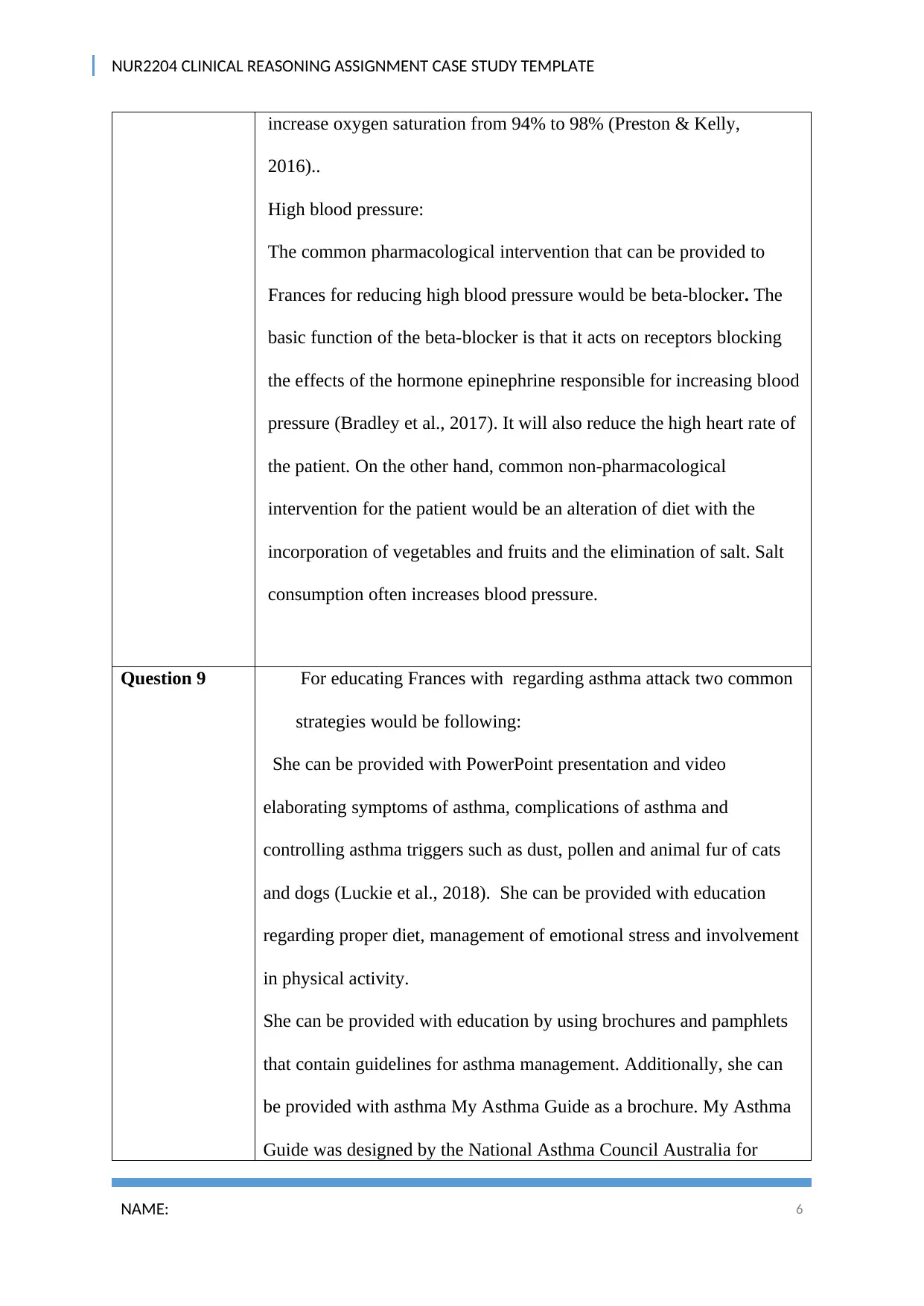
NUR2204 CLINICAL REASONING ASSIGNMENT CASE STUDY TEMPLATE
increase oxygen saturation from 94% to 98% (Preston & Kelly,
2016)..
High blood pressure:
The common pharmacological intervention that can be provided to
Frances for reducing high blood pressure would be beta-blocker. The
basic function of the beta-blocker is that it acts on receptors blocking
the effects of the hormone epinephrine responsible for increasing blood
pressure (Bradley et al., 2017). It will also reduce the high heart rate of
the patient. On the other hand, common non-pharmacological
intervention for the patient would be an alteration of diet with the
incorporation of vegetables and fruits and the elimination of salt. Salt
consumption often increases blood pressure.
Question 9 For educating Frances with regarding asthma attack two common
strategies would be following:
She can be provided with PowerPoint presentation and video
elaborating symptoms of asthma, complications of asthma and
controlling asthma triggers such as dust, pollen and animal fur of cats
and dogs (Luckie et al., 2018). She can be provided with education
regarding proper diet, management of emotional stress and involvement
in physical activity.
She can be provided with education by using brochures and pamphlets
that contain guidelines for asthma management. Additionally, she can
be provided with asthma My Asthma Guide as a brochure. My Asthma
Guide was designed by the National Asthma Council Australia for
NAME: 6
increase oxygen saturation from 94% to 98% (Preston & Kelly,
2016)..
High blood pressure:
The common pharmacological intervention that can be provided to
Frances for reducing high blood pressure would be beta-blocker. The
basic function of the beta-blocker is that it acts on receptors blocking
the effects of the hormone epinephrine responsible for increasing blood
pressure (Bradley et al., 2017). It will also reduce the high heart rate of
the patient. On the other hand, common non-pharmacological
intervention for the patient would be an alteration of diet with the
incorporation of vegetables and fruits and the elimination of salt. Salt
consumption often increases blood pressure.
Question 9 For educating Frances with regarding asthma attack two common
strategies would be following:
She can be provided with PowerPoint presentation and video
elaborating symptoms of asthma, complications of asthma and
controlling asthma triggers such as dust, pollen and animal fur of cats
and dogs (Luckie et al., 2018). She can be provided with education
regarding proper diet, management of emotional stress and involvement
in physical activity.
She can be provided with education by using brochures and pamphlets
that contain guidelines for asthma management. Additionally, she can
be provided with asthma My Asthma Guide as a brochure. My Asthma
Guide was designed by the National Asthma Council Australia for
NAME: 6
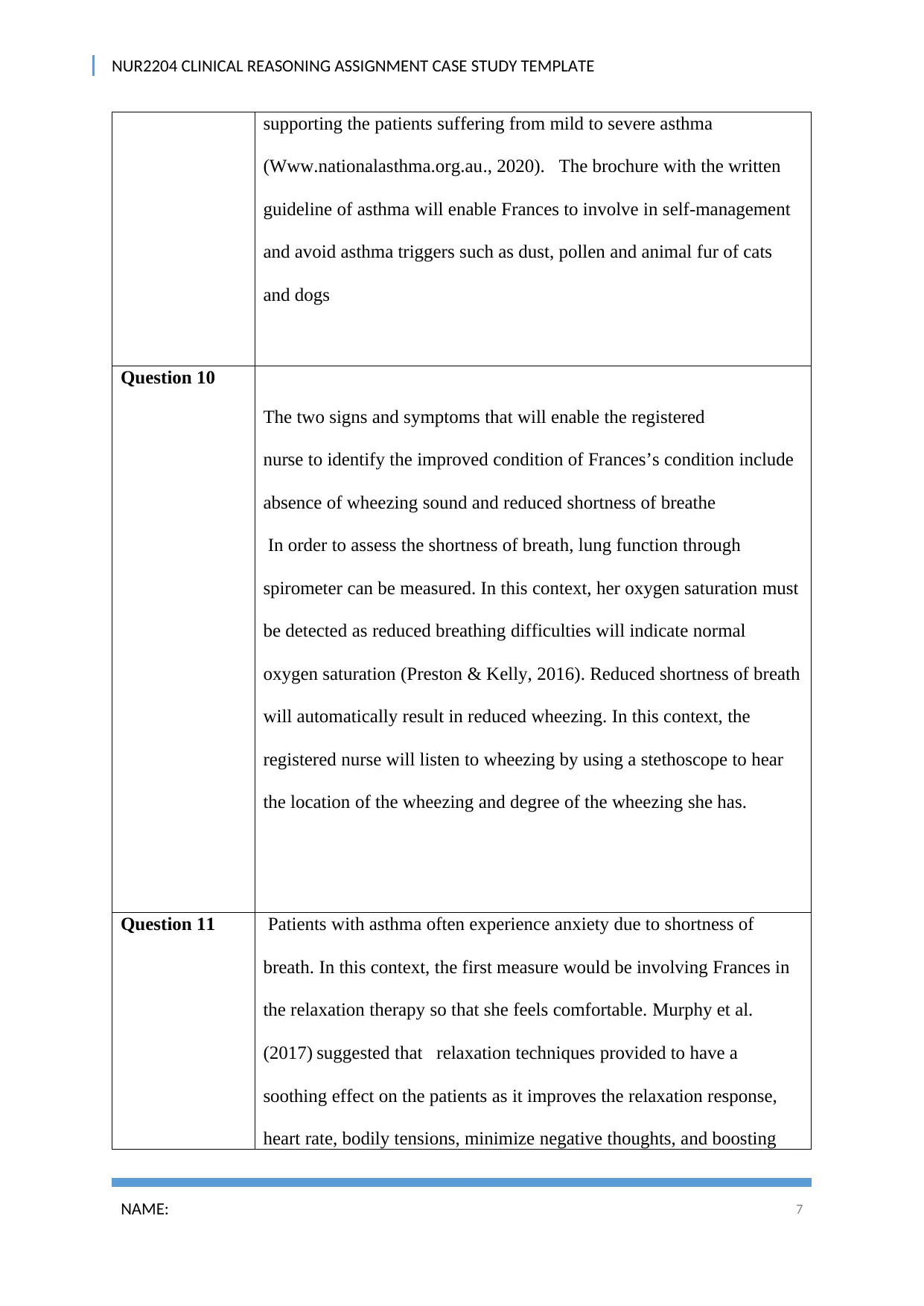
NUR2204 CLINICAL REASONING ASSIGNMENT CASE STUDY TEMPLATE
supporting the patients suffering from mild to severe asthma
(Www.nationalasthma.org.au., 2020). The brochure with the written
guideline of asthma will enable Frances to involve in self-management
and avoid asthma triggers such as dust, pollen and animal fur of cats
and dogs
Question 10
The two signs and symptoms that will enable the registered
nurse to identify the improved condition of Frances’s condition include
absence of wheezing sound and reduced shortness of breathe
In order to assess the shortness of breath, lung function through
spirometer can be measured. In this context, her oxygen saturation must
be detected as reduced breathing difficulties will indicate normal
oxygen saturation (Preston & Kelly, 2016). Reduced shortness of breath
will automatically result in reduced wheezing. In this context, the
registered nurse will listen to wheezing by using a stethoscope to hear
the location of the wheezing and degree of the wheezing she has.
Question 11 Patients with asthma often experience anxiety due to shortness of
breath. In this context, the first measure would be involving Frances in
the relaxation therapy so that she feels comfortable. Murphy et al.
(2017) suggested that relaxation techniques provided to have a
soothing effect on the patients as it improves the relaxation response,
heart rate, bodily tensions, minimize negative thoughts, and boosting
NAME: 7
supporting the patients suffering from mild to severe asthma
(Www.nationalasthma.org.au., 2020). The brochure with the written
guideline of asthma will enable Frances to involve in self-management
and avoid asthma triggers such as dust, pollen and animal fur of cats
and dogs
Question 10
The two signs and symptoms that will enable the registered
nurse to identify the improved condition of Frances’s condition include
absence of wheezing sound and reduced shortness of breathe
In order to assess the shortness of breath, lung function through
spirometer can be measured. In this context, her oxygen saturation must
be detected as reduced breathing difficulties will indicate normal
oxygen saturation (Preston & Kelly, 2016). Reduced shortness of breath
will automatically result in reduced wheezing. In this context, the
registered nurse will listen to wheezing by using a stethoscope to hear
the location of the wheezing and degree of the wheezing she has.
Question 11 Patients with asthma often experience anxiety due to shortness of
breath. In this context, the first measure would be involving Frances in
the relaxation therapy so that she feels comfortable. Murphy et al.
(2017) suggested that relaxation techniques provided to have a
soothing effect on the patients as it improves the relaxation response,
heart rate, bodily tensions, minimize negative thoughts, and boosting
NAME: 7
Paraphrase This Document
Need a fresh take? Get an instant paraphrase of this document with our AI Paraphraser
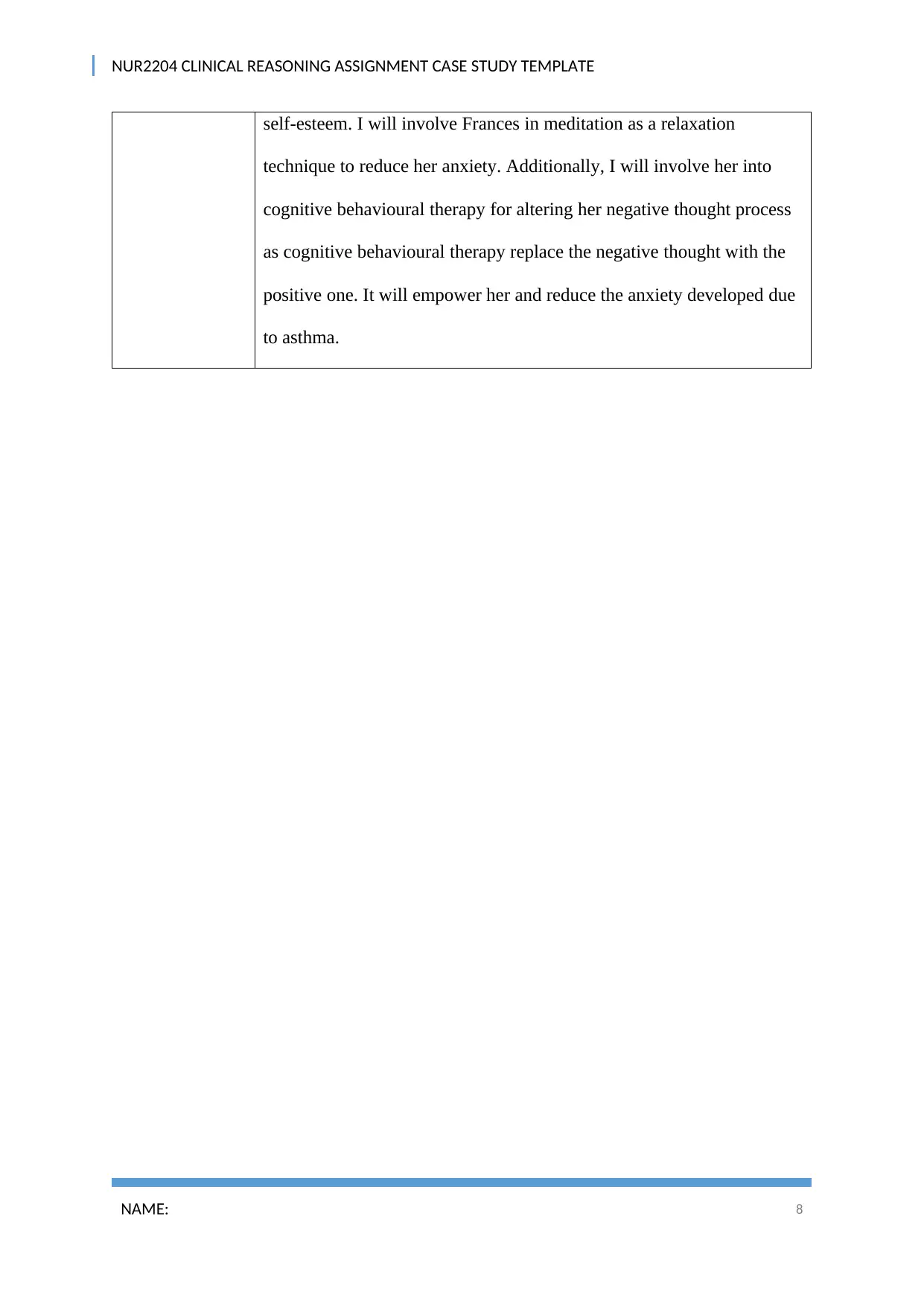
NUR2204 CLINICAL REASONING ASSIGNMENT CASE STUDY TEMPLATE
self-esteem. I will involve Frances in meditation as a relaxation
technique to reduce her anxiety. Additionally, I will involve her into
cognitive behavioural therapy for altering her negative thought process
as cognitive behavioural therapy replace the negative thought with the
positive one. It will empower her and reduce the anxiety developed due
to asthma.
NAME: 8
self-esteem. I will involve Frances in meditation as a relaxation
technique to reduce her anxiety. Additionally, I will involve her into
cognitive behavioural therapy for altering her negative thought process
as cognitive behavioural therapy replace the negative thought with the
positive one. It will empower her and reduce the anxiety developed due
to asthma.
NAME: 8
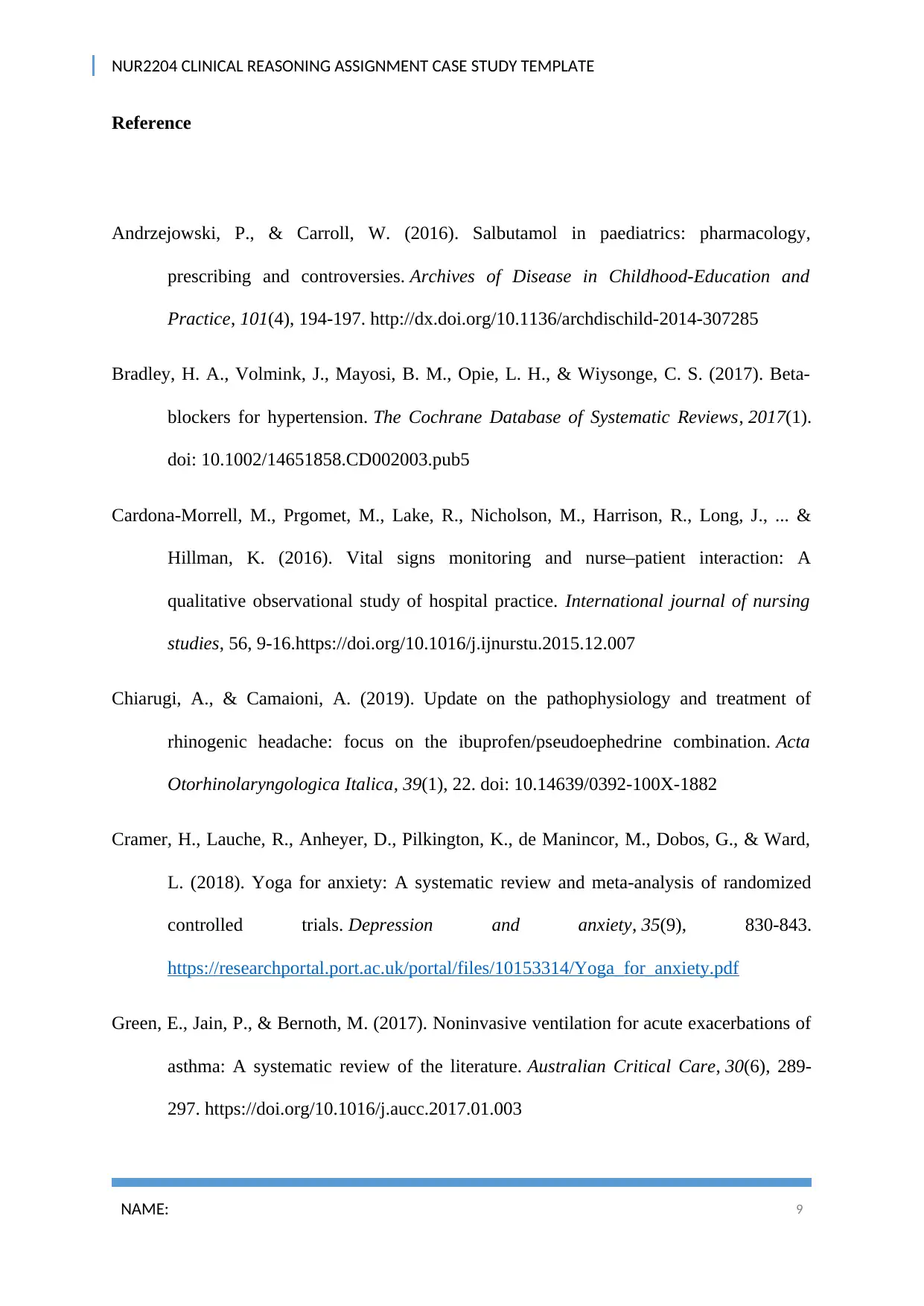
NUR2204 CLINICAL REASONING ASSIGNMENT CASE STUDY TEMPLATE
Reference
Andrzejowski, P., & Carroll, W. (2016). Salbutamol in paediatrics: pharmacology,
prescribing and controversies. Archives of Disease in Childhood-Education and
Practice, 101(4), 194-197. http://dx.doi.org/10.1136/archdischild-2014-307285
Bradley, H. A., Volmink, J., Mayosi, B. M., Opie, L. H., & Wiysonge, C. S. (2017). Beta‐
blockers for hypertension. The Cochrane Database of Systematic Reviews, 2017(1).
doi: 10.1002/14651858.CD002003.pub5
Cardona-Morrell, M., Prgomet, M., Lake, R., Nicholson, M., Harrison, R., Long, J., ... &
Hillman, K. (2016). Vital signs monitoring and nurse–patient interaction: A
qualitative observational study of hospital practice. International journal of nursing
studies, 56, 9-16.https://doi.org/10.1016/j.ijnurstu.2015.12.007
Chiarugi, A., & Camaioni, A. (2019). Update on the pathophysiology and treatment of
rhinogenic headache: focus on the ibuprofen/pseudoephedrine combination. Acta
Otorhinolaryngologica Italica, 39(1), 22. doi: 10.14639/0392-100X-1882
Cramer, H., Lauche, R., Anheyer, D., Pilkington, K., de Manincor, M., Dobos, G., & Ward,
L. (2018). Yoga for anxiety: A systematic review and meta‐analysis of randomized
controlled trials. Depression and anxiety, 35(9), 830-843.
https://researchportal.port.ac.uk/portal/files/10153314/Yoga_for_anxiety.pdf
Green, E., Jain, P., & Bernoth, M. (2017). Noninvasive ventilation for acute exacerbations of
asthma: A systematic review of the literature. Australian Critical Care, 30(6), 289-
297. https://doi.org/10.1016/j.aucc.2017.01.003
NAME: 9
Reference
Andrzejowski, P., & Carroll, W. (2016). Salbutamol in paediatrics: pharmacology,
prescribing and controversies. Archives of Disease in Childhood-Education and
Practice, 101(4), 194-197. http://dx.doi.org/10.1136/archdischild-2014-307285
Bradley, H. A., Volmink, J., Mayosi, B. M., Opie, L. H., & Wiysonge, C. S. (2017). Beta‐
blockers for hypertension. The Cochrane Database of Systematic Reviews, 2017(1).
doi: 10.1002/14651858.CD002003.pub5
Cardona-Morrell, M., Prgomet, M., Lake, R., Nicholson, M., Harrison, R., Long, J., ... &
Hillman, K. (2016). Vital signs monitoring and nurse–patient interaction: A
qualitative observational study of hospital practice. International journal of nursing
studies, 56, 9-16.https://doi.org/10.1016/j.ijnurstu.2015.12.007
Chiarugi, A., & Camaioni, A. (2019). Update on the pathophysiology and treatment of
rhinogenic headache: focus on the ibuprofen/pseudoephedrine combination. Acta
Otorhinolaryngologica Italica, 39(1), 22. doi: 10.14639/0392-100X-1882
Cramer, H., Lauche, R., Anheyer, D., Pilkington, K., de Manincor, M., Dobos, G., & Ward,
L. (2018). Yoga for anxiety: A systematic review and meta‐analysis of randomized
controlled trials. Depression and anxiety, 35(9), 830-843.
https://researchportal.port.ac.uk/portal/files/10153314/Yoga_for_anxiety.pdf
Green, E., Jain, P., & Bernoth, M. (2017). Noninvasive ventilation for acute exacerbations of
asthma: A systematic review of the literature. Australian Critical Care, 30(6), 289-
297. https://doi.org/10.1016/j.aucc.2017.01.003
NAME: 9
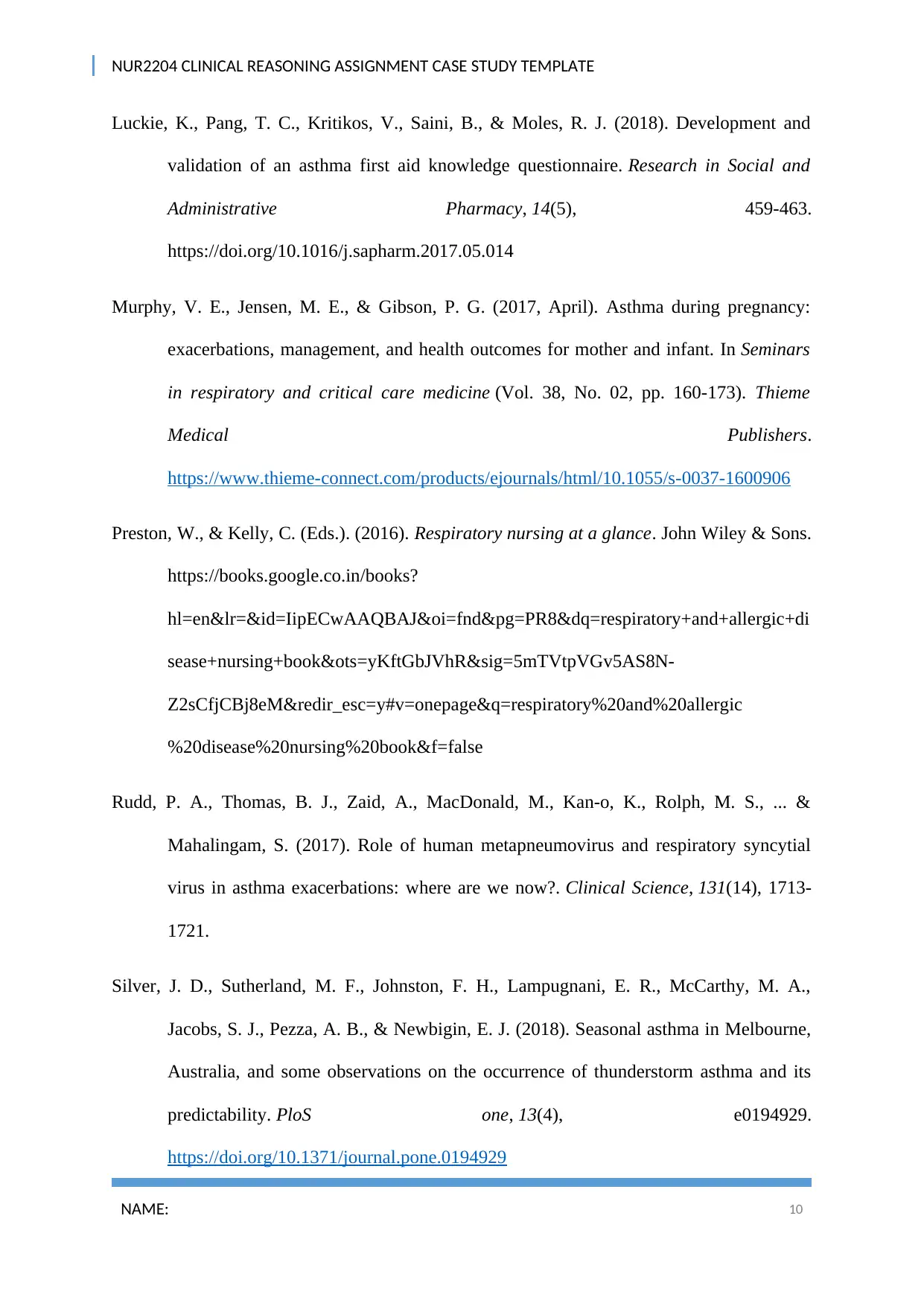
NUR2204 CLINICAL REASONING ASSIGNMENT CASE STUDY TEMPLATE
Luckie, K., Pang, T. C., Kritikos, V., Saini, B., & Moles, R. J. (2018). Development and
validation of an asthma first aid knowledge questionnaire. Research in Social and
Administrative Pharmacy, 14(5), 459-463.
https://doi.org/10.1016/j.sapharm.2017.05.014
Murphy, V. E., Jensen, M. E., & Gibson, P. G. (2017, April). Asthma during pregnancy:
exacerbations, management, and health outcomes for mother and infant. In Seminars
in respiratory and critical care medicine (Vol. 38, No. 02, pp. 160-173). Thieme
Medical Publishers.
https://www.thieme-connect.com/products/ejournals/html/10.1055/s-0037-1600906
Preston, W., & Kelly, C. (Eds.). (2016). Respiratory nursing at a glance. John Wiley & Sons.
https://books.google.co.in/books?
hl=en&lr=&id=IipECwAAQBAJ&oi=fnd&pg=PR8&dq=respiratory+and+allergic+di
sease+nursing+book&ots=yKftGbJVhR&sig=5mTVtpVGv5AS8N-
Z2sCfjCBj8eM&redir_esc=y#v=onepage&q=respiratory%20and%20allergic
%20disease%20nursing%20book&f=false
Rudd, P. A., Thomas, B. J., Zaid, A., MacDonald, M., Kan-o, K., Rolph, M. S., ... &
Mahalingam, S. (2017). Role of human metapneumovirus and respiratory syncytial
virus in asthma exacerbations: where are we now?. Clinical Science, 131(14), 1713-
1721.
Silver, J. D., Sutherland, M. F., Johnston, F. H., Lampugnani, E. R., McCarthy, M. A.,
Jacobs, S. J., Pezza, A. B., & Newbigin, E. J. (2018). Seasonal asthma in Melbourne,
Australia, and some observations on the occurrence of thunderstorm asthma and its
predictability. PloS one, 13(4), e0194929.
https://doi.org/10.1371/journal.pone.0194929
NAME: 10
Luckie, K., Pang, T. C., Kritikos, V., Saini, B., & Moles, R. J. (2018). Development and
validation of an asthma first aid knowledge questionnaire. Research in Social and
Administrative Pharmacy, 14(5), 459-463.
https://doi.org/10.1016/j.sapharm.2017.05.014
Murphy, V. E., Jensen, M. E., & Gibson, P. G. (2017, April). Asthma during pregnancy:
exacerbations, management, and health outcomes for mother and infant. In Seminars
in respiratory and critical care medicine (Vol. 38, No. 02, pp. 160-173). Thieme
Medical Publishers.
https://www.thieme-connect.com/products/ejournals/html/10.1055/s-0037-1600906
Preston, W., & Kelly, C. (Eds.). (2016). Respiratory nursing at a glance. John Wiley & Sons.
https://books.google.co.in/books?
hl=en&lr=&id=IipECwAAQBAJ&oi=fnd&pg=PR8&dq=respiratory+and+allergic+di
sease+nursing+book&ots=yKftGbJVhR&sig=5mTVtpVGv5AS8N-
Z2sCfjCBj8eM&redir_esc=y#v=onepage&q=respiratory%20and%20allergic
%20disease%20nursing%20book&f=false
Rudd, P. A., Thomas, B. J., Zaid, A., MacDonald, M., Kan-o, K., Rolph, M. S., ... &
Mahalingam, S. (2017). Role of human metapneumovirus and respiratory syncytial
virus in asthma exacerbations: where are we now?. Clinical Science, 131(14), 1713-
1721.
Silver, J. D., Sutherland, M. F., Johnston, F. H., Lampugnani, E. R., McCarthy, M. A.,
Jacobs, S. J., Pezza, A. B., & Newbigin, E. J. (2018). Seasonal asthma in Melbourne,
Australia, and some observations on the occurrence of thunderstorm asthma and its
predictability. PloS one, 13(4), e0194929.
https://doi.org/10.1371/journal.pone.0194929
NAME: 10
Secure Best Marks with AI Grader
Need help grading? Try our AI Grader for instant feedback on your assignments.
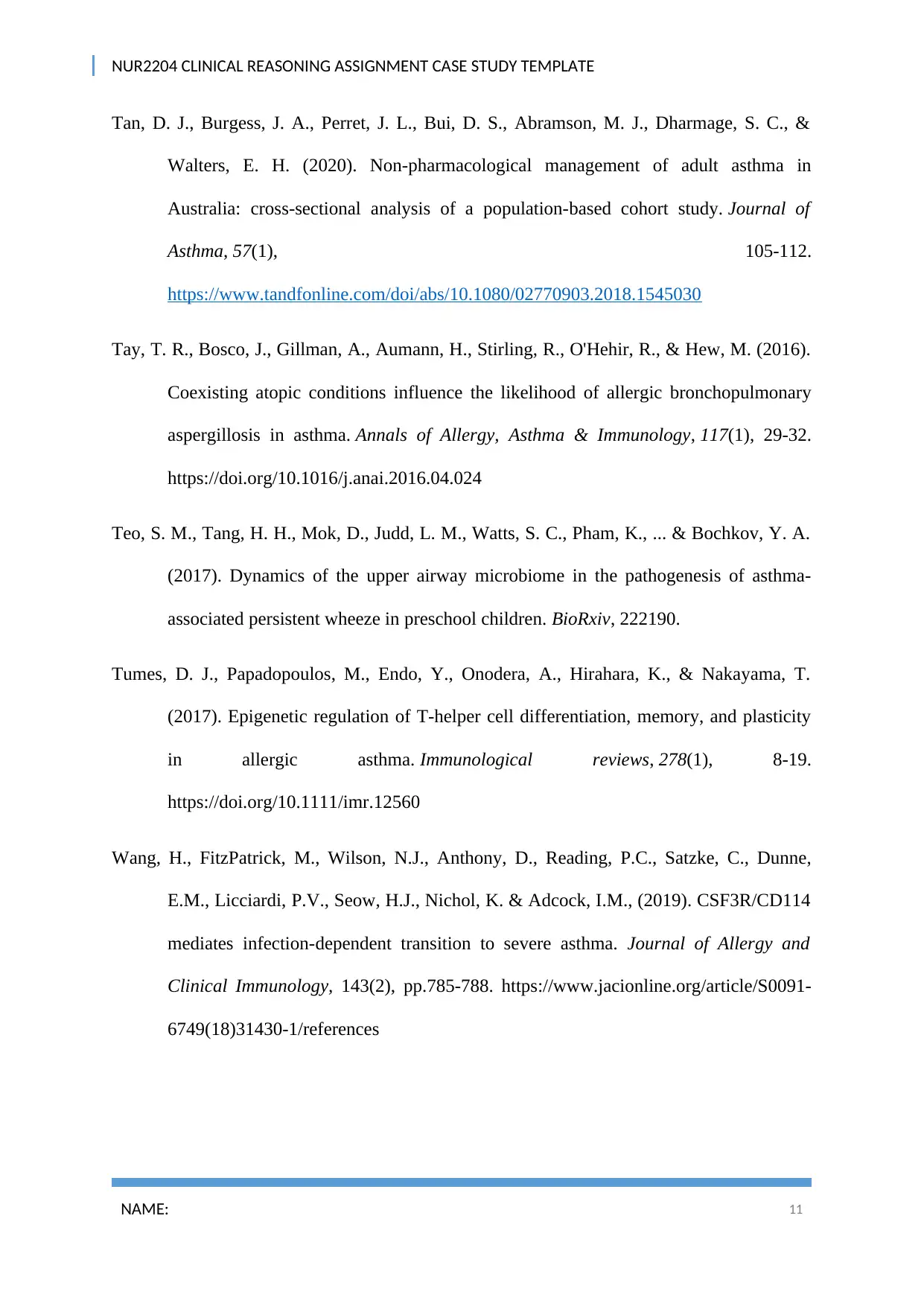
NUR2204 CLINICAL REASONING ASSIGNMENT CASE STUDY TEMPLATE
Tan, D. J., Burgess, J. A., Perret, J. L., Bui, D. S., Abramson, M. J., Dharmage, S. C., &
Walters, E. H. (2020). Non-pharmacological management of adult asthma in
Australia: cross-sectional analysis of a population-based cohort study. Journal of
Asthma, 57(1), 105-112.
https://www.tandfonline.com/doi/abs/10.1080/02770903.2018.1545030
Tay, T. R., Bosco, J., Gillman, A., Aumann, H., Stirling, R., O'Hehir, R., & Hew, M. (2016).
Coexisting atopic conditions influence the likelihood of allergic bronchopulmonary
aspergillosis in asthma. Annals of Allergy, Asthma & Immunology, 117(1), 29-32.
https://doi.org/10.1016/j.anai.2016.04.024
Teo, S. M., Tang, H. H., Mok, D., Judd, L. M., Watts, S. C., Pham, K., ... & Bochkov, Y. A.
(2017). Dynamics of the upper airway microbiome in the pathogenesis of asthma-
associated persistent wheeze in preschool children. BioRxiv, 222190.
Tumes, D. J., Papadopoulos, M., Endo, Y., Onodera, A., Hirahara, K., & Nakayama, T.
(2017). Epigenetic regulation of T‐helper cell differentiation, memory, and plasticity
in allergic asthma. Immunological reviews, 278(1), 8-19.
https://doi.org/10.1111/imr.12560
Wang, H., FitzPatrick, M., Wilson, N.J., Anthony, D., Reading, P.C., Satzke, C., Dunne,
E.M., Licciardi, P.V., Seow, H.J., Nichol, K. & Adcock, I.M., (2019). CSF3R/CD114
mediates infection-dependent transition to severe asthma. Journal of Allergy and
Clinical Immunology, 143(2), pp.785-788. https://www.jacionline.org/article/S0091-
6749(18)31430-1/references
NAME: 11
Tan, D. J., Burgess, J. A., Perret, J. L., Bui, D. S., Abramson, M. J., Dharmage, S. C., &
Walters, E. H. (2020). Non-pharmacological management of adult asthma in
Australia: cross-sectional analysis of a population-based cohort study. Journal of
Asthma, 57(1), 105-112.
https://www.tandfonline.com/doi/abs/10.1080/02770903.2018.1545030
Tay, T. R., Bosco, J., Gillman, A., Aumann, H., Stirling, R., O'Hehir, R., & Hew, M. (2016).
Coexisting atopic conditions influence the likelihood of allergic bronchopulmonary
aspergillosis in asthma. Annals of Allergy, Asthma & Immunology, 117(1), 29-32.
https://doi.org/10.1016/j.anai.2016.04.024
Teo, S. M., Tang, H. H., Mok, D., Judd, L. M., Watts, S. C., Pham, K., ... & Bochkov, Y. A.
(2017). Dynamics of the upper airway microbiome in the pathogenesis of asthma-
associated persistent wheeze in preschool children. BioRxiv, 222190.
Tumes, D. J., Papadopoulos, M., Endo, Y., Onodera, A., Hirahara, K., & Nakayama, T.
(2017). Epigenetic regulation of T‐helper cell differentiation, memory, and plasticity
in allergic asthma. Immunological reviews, 278(1), 8-19.
https://doi.org/10.1111/imr.12560
Wang, H., FitzPatrick, M., Wilson, N.J., Anthony, D., Reading, P.C., Satzke, C., Dunne,
E.M., Licciardi, P.V., Seow, H.J., Nichol, K. & Adcock, I.M., (2019). CSF3R/CD114
mediates infection-dependent transition to severe asthma. Journal of Allergy and
Clinical Immunology, 143(2), pp.785-788. https://www.jacionline.org/article/S0091-
6749(18)31430-1/references
NAME: 11
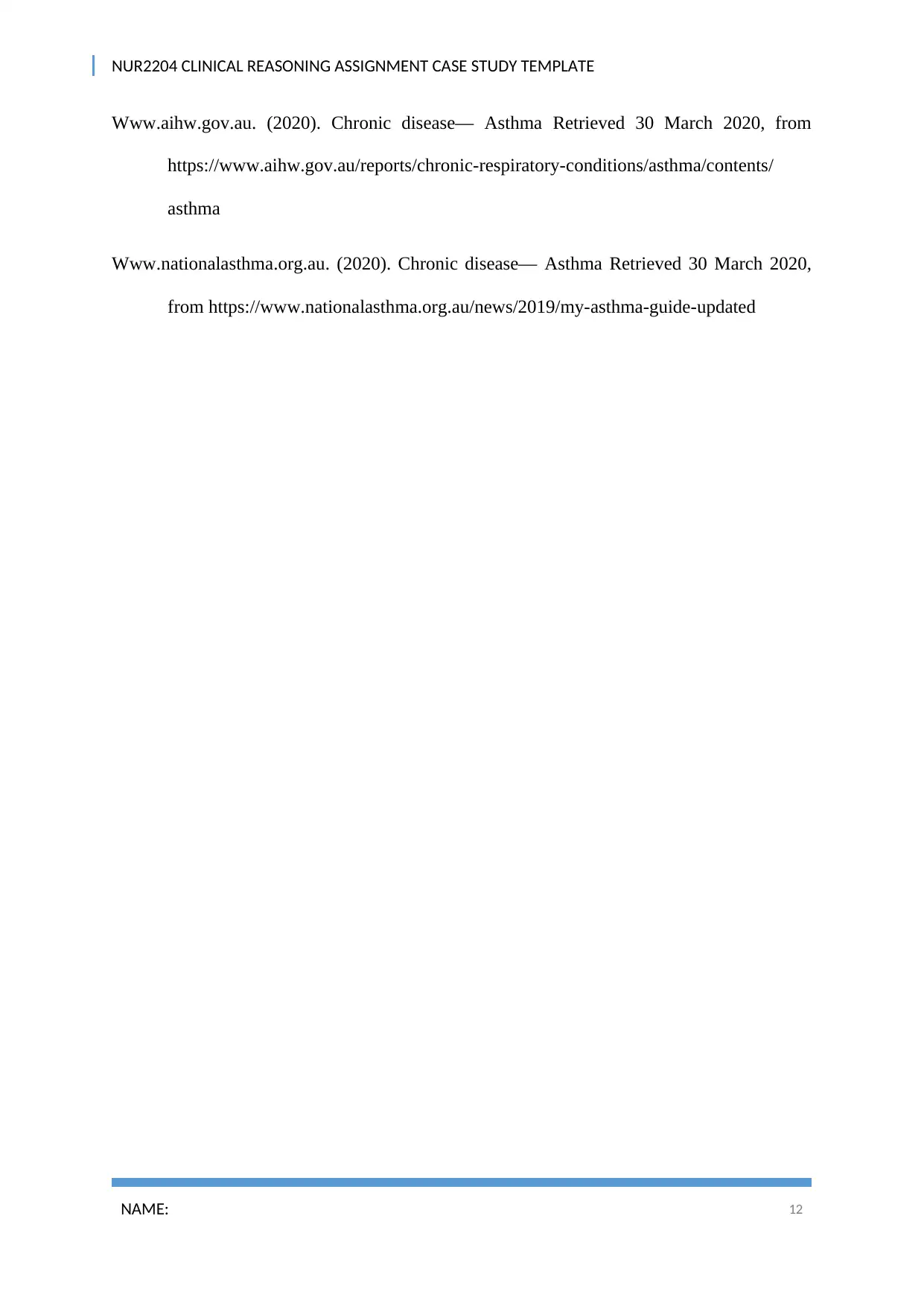
NUR2204 CLINICAL REASONING ASSIGNMENT CASE STUDY TEMPLATE
Www.aihw.gov.au. (2020). Chronic disease— Asthma Retrieved 30 March 2020, from
https://www.aihw.gov.au/reports/chronic-respiratory-conditions/asthma/contents/
asthma
Www.nationalasthma.org.au. (2020). Chronic disease— Asthma Retrieved 30 March 2020,
from https://www.nationalasthma.org.au/news/2019/my-asthma-guide-updated
NAME: 12
Www.aihw.gov.au. (2020). Chronic disease— Asthma Retrieved 30 March 2020, from
https://www.aihw.gov.au/reports/chronic-respiratory-conditions/asthma/contents/
asthma
Www.nationalasthma.org.au. (2020). Chronic disease— Asthma Retrieved 30 March 2020,
from https://www.nationalasthma.org.au/news/2019/my-asthma-guide-updated
NAME: 12
1 out of 12
Related Documents
Your All-in-One AI-Powered Toolkit for Academic Success.
+13062052269
info@desklib.com
Available 24*7 on WhatsApp / Email
![[object Object]](/_next/static/media/star-bottom.7253800d.svg)
Unlock your academic potential
© 2024 | Zucol Services PVT LTD | All rights reserved.




